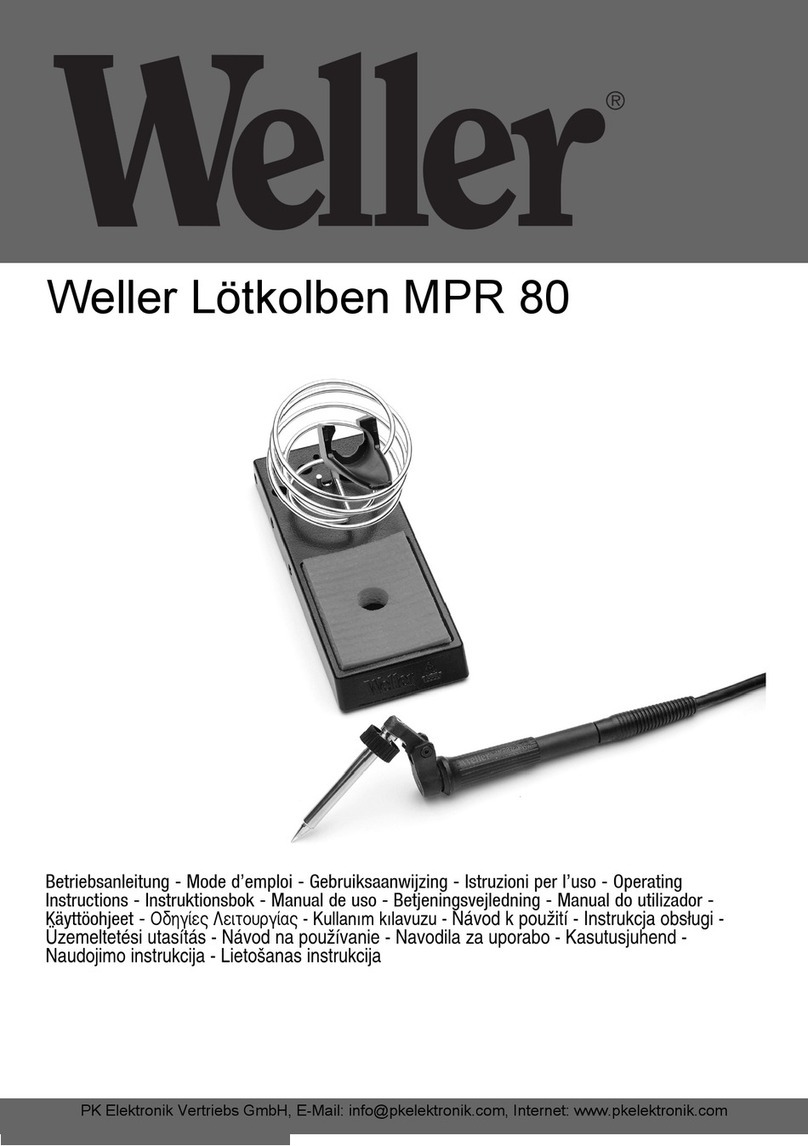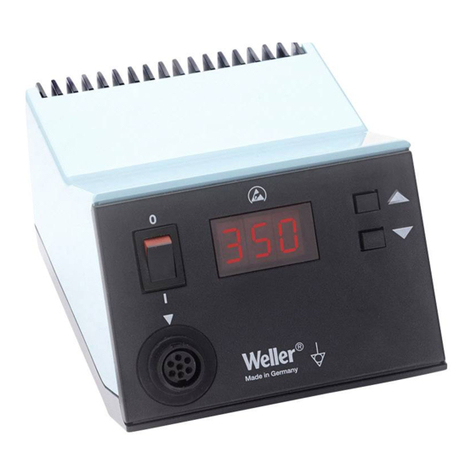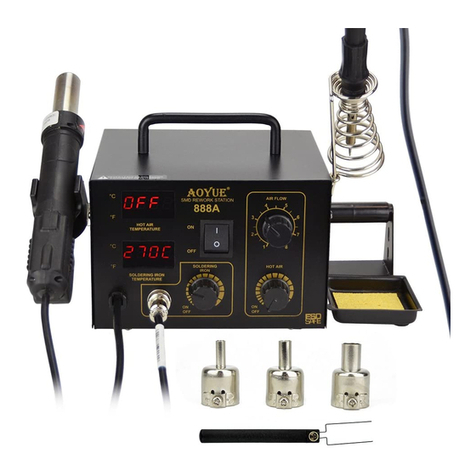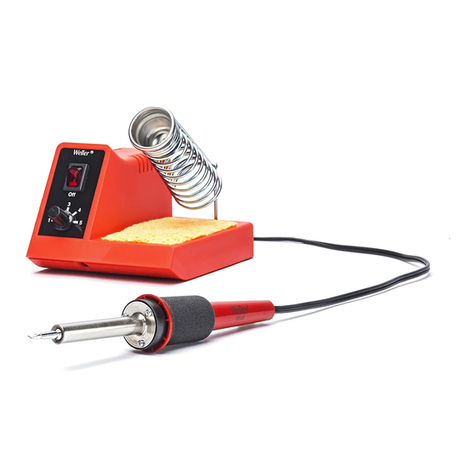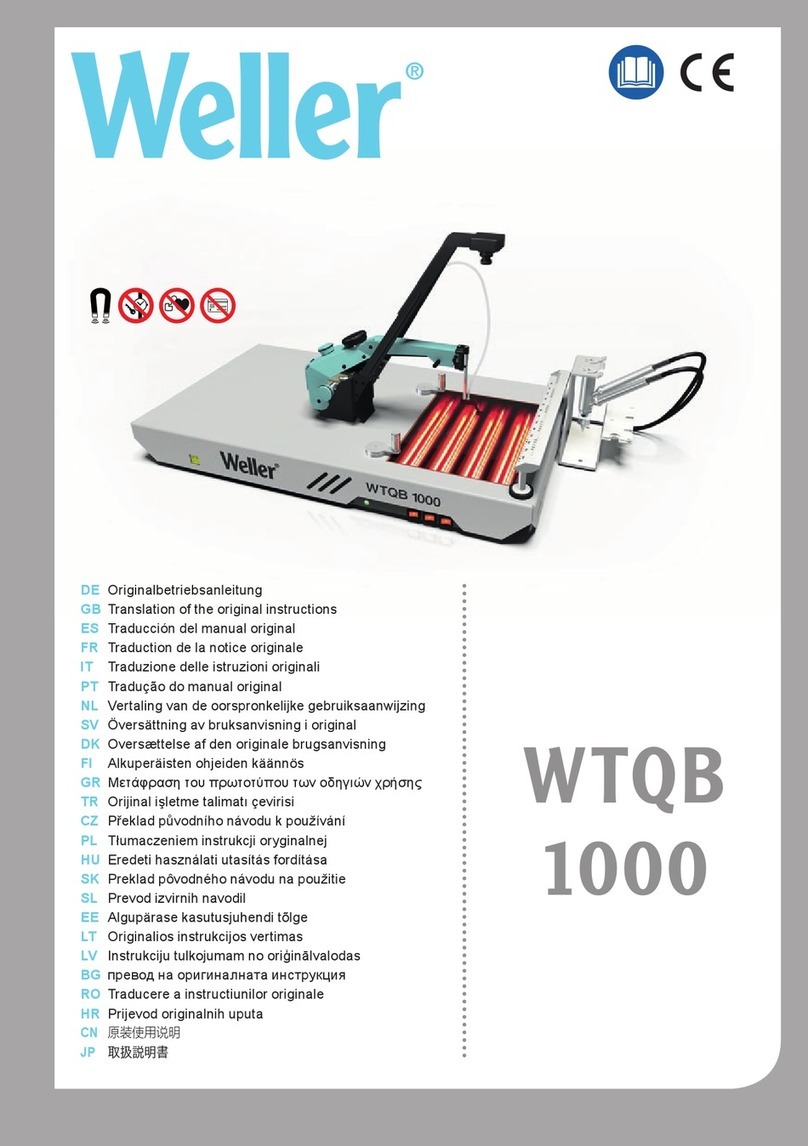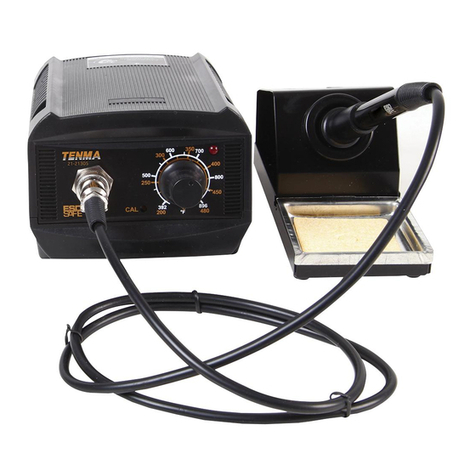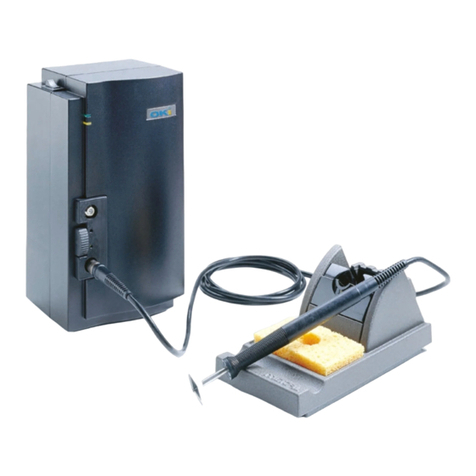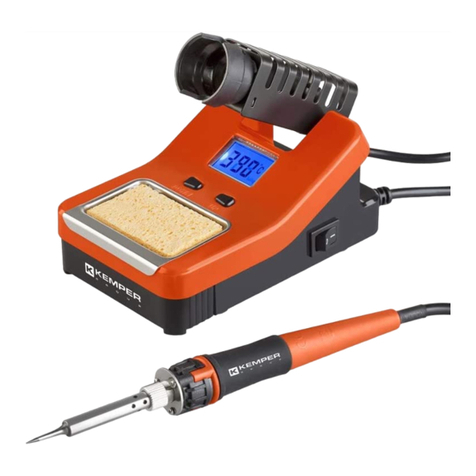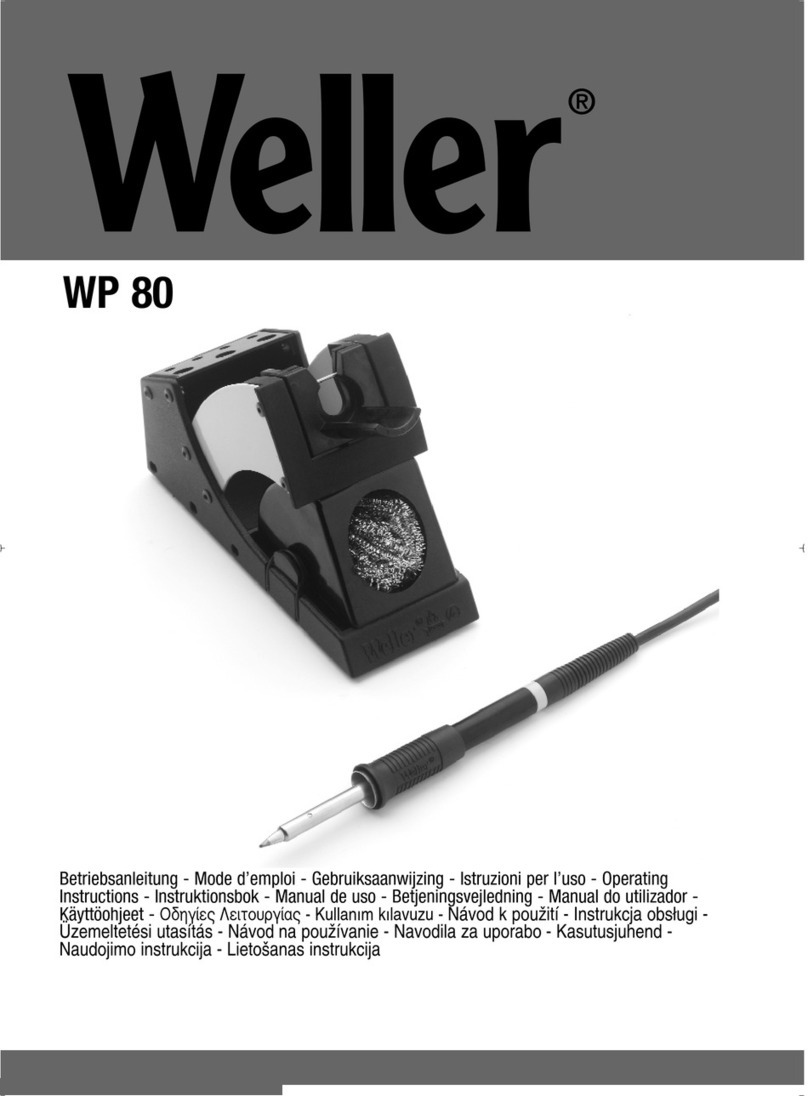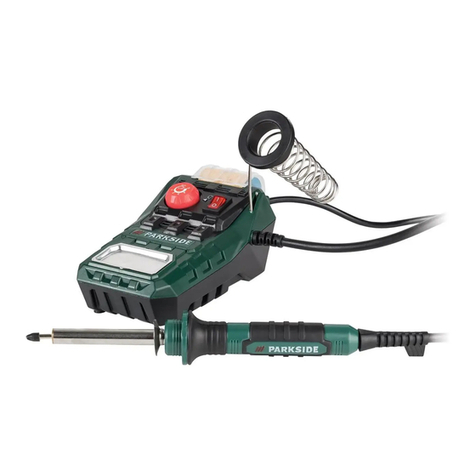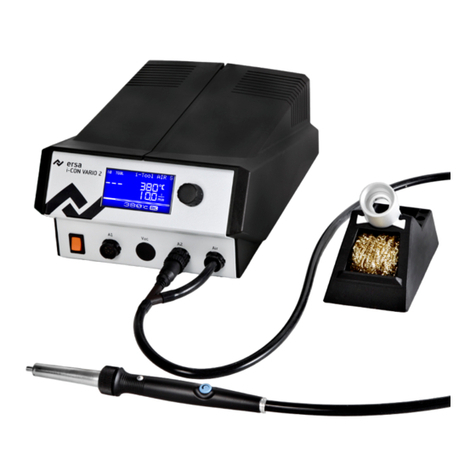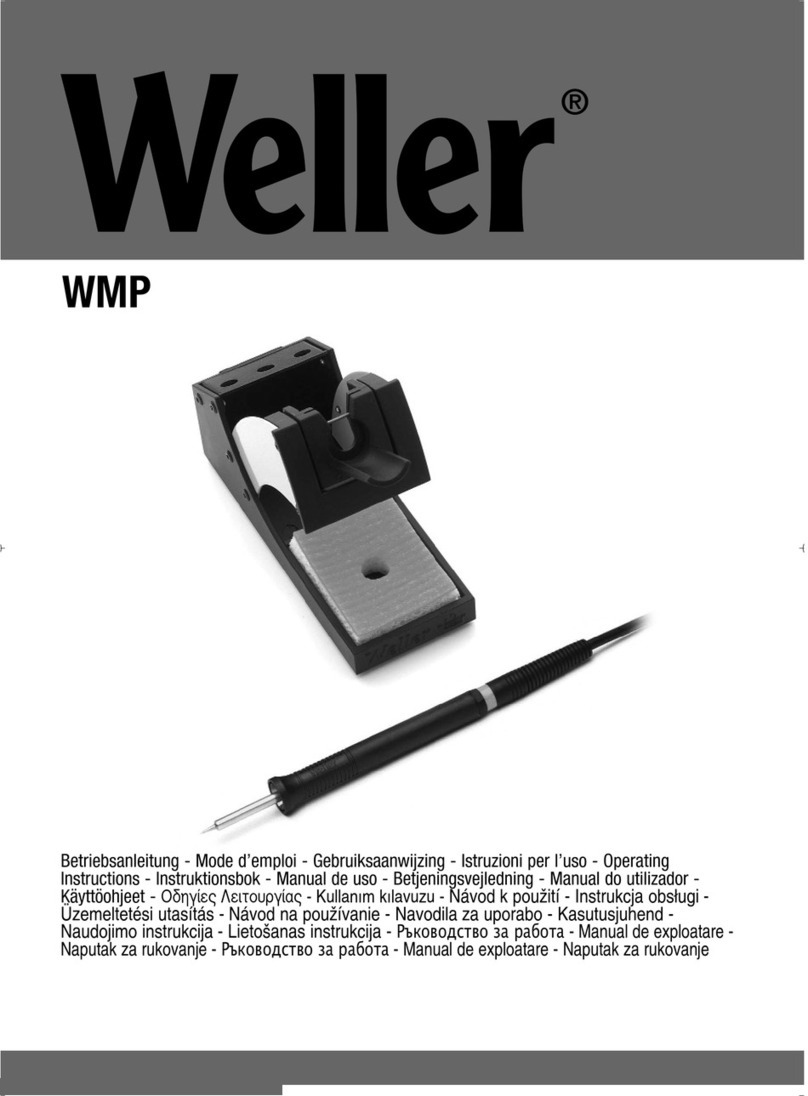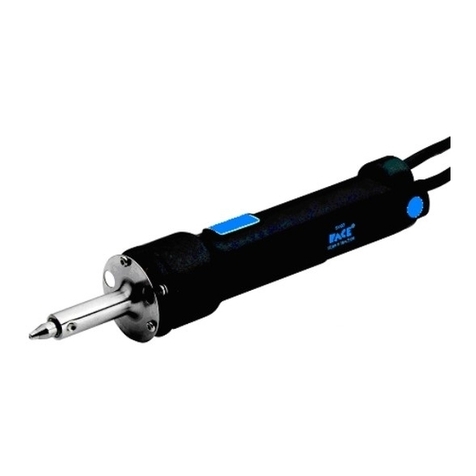PCB Vapor Phase User manual

Vapor Phase Soldering Machine
Vapor Phase One
Instruction manual
PCB Arts GmbH
Kurgartenstraße 59, 90762 Fürth - DE-Mail
vpo@pcb-arts.com, https://www.pcb-arts.com
Please read this manual before operating the Vapor Phase One and follow the instructions
when operating. Keep these instructions near the machine.

PCB Arts GmbH Instruction Manual Vapor Phase One Page 2 of 27

PCB Arts GmbH Instruction Manual Vapor Phase One Page 3 of 27
Thank you for purchasing a Vapor Phase One.
This document shows you how to use the vapor phase soldering system properly.
Please read this document and the enclosed safety instructions before using the
vapor phase soldering system. If you have any questions, please do not hesitate to
contact us at the e-mail address given below.
The information in this document corresponds to the software version of delivery .
PCB Arts may make improvements and changes in this documentation and software
at any time without notice.
For an up-to-date version, visit our blog at www.blog.pcb-arts.com.
There you will also find tutorials, tips & tricks.
Enjoy using your new vapor phase soldering system!
PCB Arts GmbH ©
Kurgartenstraße 59, 90762 Fürth, DE
E-mail: vpo@pcb-arts.com
Internet: www.pcb-arts.com

PCB Arts GmbH Instruction Manual Vapor Phase One Page 4 of 27
Content
1. Before operation................................................................................................................. 6
1.1 Scope of delivery ......................................................................................................... 6
1.2 Intended use................................................................................................................ 6
1.3 Process description...................................................................................................... 6
1.4 Process description...................................................................................................... 6
1.5 The heat transfer medium........................................................................................... 7
1.6 Footprint ...................................................................................................................... 7
1.6.1 Filling quantities....................................................................................................... 8
1.7 First commissioning ..................................................................................................... 8
1.8 Description of the plant............................................................................................... 8
1.9 Safety devices .............................................................................................................. 8
1.9.1 Monitoring of the plant cover.............................................................................. 8
1.9.2 Housing................................................................................................................. 8
1.9.3 Ventilated lid ........................................................................................................ 9
1.9.4 Dimensioning of the heating system.................................................................... 9
1.9.5 Limitation of steam ceiling height........................................................................ 9
1.9.6 Monitoring the cooling circuit temperature ........................................................ 9
1.9.7 Heating temperature monitoring......................................................................... 9
1.9.8 Monitoring the process chamber temperature ................................................... 9
1.9.9 Trial Chamber ....................................................................................................... 9
1.10 Cooling system............................................................................................................. 9
1.10.1 Initial filling of the vapor phase soldering system with distilled water .............10
1.10.2 Draining the cooling medium............................................................................. 10
1.11 Damage in transit.......................................................................................................10
1.11.1 Transport of the plant............................................................................................11
1.12 Power connection......................................................................................................12
2. Operation of the plant ...................................................................................................... 13
2.1 Technical data............................................................................................................ 13
2.2 Part designations .......................................................................................................13
2.3 General operation...................................................................................................... 15
2.3.1 Operating the touch panel.....................................................................................15
2.3.2 Operating the Vapor Phase One ............................................................................ 16
2.3.3 SD card ...................................................................................................................17

PCB Arts GmbH Instruction Manual Vapor Phase One Page 5 of 27
2.4 Attaching the temperature sensor ............................................................................ 18
2.5 Creating your own soldering profile..........................................................................18
3. Maintenance .....................................................................................................................20
3.1 Cleaning the machine ................................................................................................ 20
3.2 Cleaning the process chamber .................................................................................. 20
3.3 Temperature sensors detached from heater ............................................................20
3.4 Installing software updates ....................................................................................... 21
3.5 Running the self-test..................................................................................................22
4. Malfunctions ..................................................................................................................... 23
4.1 Plant cannot be started .............................................................................................23
4.2 Heating does not work ..............................................................................................23
4.3 Lid does not travel ..................................................................................................... 23
4.4 Lift does not move ..................................................................................................... 23
4.5 Profile does not start.................................................................................................23
4.6 Cooling water overtemperature................................................................................24
4.7 Oscillation of the ACTUAL temperature in the soldering profile .............................. 24
5. Operation tips ................................................................................................................... 25
5.1 Soldering defects .......................................................................................................25
5.1.1 Tombstone effect ............................................................................................... 25
5.1.2 Wicking effect.....................................................................................................25
5.1.3 Solder beads.......................................................................................................25
5.1.4 Solder paste does not melt ................................................................................26
5.2 Solder paste selection................................................................................................ 26
5.3 Double-sided boards..................................................................................................26
5.4 Cleaning of printed circuit boards .............................................................................26
6. Warranty ........................................................................................................................... 27
6.1 Guarantee and warranty ...........................................................................................27
6.2 Disclaimer ..................................................................................................................27

PCB Arts GmbH Instruction Manual Vapor Phase One Page 6 of 27
1. Before operation
1.1 Scope of delivery
•Vapor Phase One
•Power cable EU / US
•SD card
•USB SD card adapter
•Injection syringe for emptying the medium
•Brush for cleaning
•One pair of cotton gloves (for touch screen applications)
•Funnel for filling the water tank
•Torx© T20 key for opening the hose cover
•Four Torx© T20 replacement screws for the hose cover
1.2 Intended use
The vapor phase soldering system is to be used for soldering printed circuit boards with
assembled components . Temperatures up to a maximum of 240°C are intended. Other uses
of the equipment are not permitted. The limit values specified in this document must not be
exceeded under any circumstances. The operational safety of the equipment supplied is only
guaranteed if it is used as intended.
1.3 Process description
Vapor phase soldering uses a similar physical principle to a heat pipe. A heat source causes a
liquid to boil, i.e. vaporize. This vapor transports the energy of the heat source to the heat
sink - the assembly. The vapor condenses first at the particularly cool points and thus
releases the greatest amount of energy at these points. In the vapor phase soldering system,
a specially developed inert medium is used, which boils between 230°C and 240°C
depending on the type of medium. The condensing vapor gently heats the assembly to the
maximum boiling temperature. Meanwhile, the solder on the assembly liquefies. When the
assembly is removed from the vapor layer, the solder solidifies.
1.4 Process description
First, the soldering chamber is opened by operating the touch panel. After the assembled
component is placed in the soldering chamber on the soldering grid, it can be closed again
with the help of the touch screen. After the soldering chamber is securely closed, it is
possible to start the soldering process via touch panel input.
The heating element brings the soldering medium to its boiling temperature, while the
soldering grid with the assembled component moves along the specified soldering profile.
When the boiling temperature of the soldering medium has been reached, a vapor layer is

PCB Arts GmbH Instruction Manual Vapor Phase One Page 7 of 27
formed. This then has an identical temperature to the boiling temperature of the inert
medium. This vapor layer thus also defines a large part of the soldering zone. When the
specified temperature profile provides for the soldering temperatures, the assembled
assembly is moved into the vapor layer. The vapor condenses on the surface of the solder as
this is lower than the boiling temperature. The condensation process is finished as soon as
the soldering material has reached the temperature of the steam.
The soldering grid with the soldering material is moved upwards in the process chamber,
and the cooling process of the process chamber begins. The process chamber is cooled down
with the help of fans, which ensures almost complete condensation of the remaining
medium vapor. Once a certain temperature of the medium has been reached, the process
chamber is released for opening. The user can now open the process chamber via touch
panel and remove the still warm or hot solder with cotton gloves.
1.5 The heat transfer medium
PCB Arts uses the process medium of the company "Solvay Solexis" with the brand name
"Galden®". This is perfluoropolyether, which is composed exclusively of carbon, fluorine and
oxygen atoms. The advantages of Galden© are:
•Dielectric properties
•High material compatibility
•No flash point
•High heat transfer coefficient
•Not a hazardous substance in the sense of occupational health and safety
1.6 Footprint
The "Vapor Phase One" must be set up with at least 20cm of protrusion all around. Thus, an
installation area of 900mm (width) x 700mm (depth) x 900mm (height) is required. The
installation surface must be horizontal and temperature resistant (at least 150°C). Ideally,
the soldering machine should be placed near a window to prevent odors from developing.
The temperature of the operating room must not exceed 35°C. Also, the humidity of the air
must not exceed 70%. Make sure that the vapor phase soldering system has enough space
above the lid so that there is no danger of crushing.
•The soldering unit must not be installed near fire detectors or sprinkler systems.
•The soldering system must not be operated in potentially explosive atmospheres.
•With the mains plug disconnected, the cooling water reservoir is to be filled up to
the specified level with distilled water only.
•The process medium reservoir must be filled up to the specified level with the power
plug disconnected; the heating coils at the bottom of the solder pot must always be
covered.

PCB Arts GmbH Instruction Manual Vapor Phase One Page 8 of 27
•The soldering equipment must not be put into operation in places above 2000
meters above sea level.
1.6.1 Filling quantities
Medium: At least 750ml process medium.
Caution: During installation, make sure that the heating tube in the process vessel is always covered with
medium!
Cooling water: Pour approx. 1250ml liters of distilled water into the cooling circuit.
1.7 Initial startup
1. Make sure that the installation surface has been selected correctly.
2. Initialize the SD card as described in 2.3.3
3. First fill the water tank initially with water as described in 1.10.1
4. Set the voltage of the vapor phase correctly as described in 1.12
5. Then plug in the mains plug of the vapor phase soldering system.
6. Turn on the main switch of the vapor phase soldering system so that it starts and
calibrates.
7. You can now swipe to the left and right on the touchscreen to change the operating
views. On the first operating view, you will see the "Open Lid" button. Press this
button and the process lid opens automatically. Now carefully fill the soldering
medium into the process vat so that the filling quantity is between the minimum and
maximum of the dipstick.
1.8 Description of the plant
The system is intended for reflow soldering of small quantities, prototypes and individual
pieces. Continuous operation of the system is not intended. The maximum working speed is
limited by the soldering profile, the corresponding cooling speed and the opening
temperature of the process chamber.
1.9 Safety devices
1.9.1 Monitoring of the plant cover
The travel speed is limited by the hardware with regard to operating voltage and
transmission ratio. There are various current limitations of the motor current as well as
overcurrent shutdowns. When an overcurrent event is registered, the lid automatically
moves up to prevent crushing between the process vat and the lid.
1.9.2 Housing
All contactable edges are rounded by design. No sharp-edged parts are installed. The
hexagons on the housing can lead to chafing, these should be touched with care.

PCB Arts GmbH Instruction Manual Vapor Phase One Page 9 of 27
1.9.3 Ventilated lid
The lid of the process chamber is protected from contact by a polyoxymethylene (POM)
plate. Increased temperatures are reached at the stainless steel lid, which is located under
the POM plastic. This area cannot be touched and is insulated with the polyoxymethylene
plate. In addition, there is an active fan which cools the area between the stainless steel lid
and the POM.
1.9.4 Dimensioning of the heating
The heater is dimensioned so that a maximum energy of 3.125W/cm² is achieved. Thus, the
maximum power, which is specified for Galden©, is not reached.
1.9.5 Limitation of the steam ceiling height
The steam ceiling is limited in the process vessel by cooling blocks, which are mounted at a
certain height on the outer wall of the process vessel. These cooling blocks are part of an
actively cooled water circuit. Thus, the steam ceiling height is physically limited via these.
1.9.6 Monitoring the cooling circuit temperature
The water circuit, which is used to limit the vapor ceiling height, is monitored with a
temperature sensor. If the water temperature rises above X°C / X°F, the Vapor Phase One
will not allow soldering.
1.9.7 Heating temperature monitoring
In addition to the correct dimensioning of the heating, it is monitored and controlled by
software. Should the software control fail to function for inexplicable reasons, dedicated
evaluation electronics ensure an emergency shutdown in the event of overtemperature.
1.9.8 Monitoring the process chamber temperature
The process chamber can open when the temperature of the galde is below a user-
adjustable temperature. This setting can be adjusted in the display ("Eco", "Standard" or
"Fast").
1.9.9 Trial Chamber
The lid of the process chamber cannot be moved manually, this is controlled by a self-locking
motor.
1.10 Cooling system
Caution: Never fill water into the cooling system while the vapor phase soldering
system is connected to the socket!
Attention: Only distilled water may be used for cooling. Damage to the unit due to
calcification is excluded from the warranty.
The water is circulated throughout and cooled down by two radiators. For this purpose, the
fans of the radiators must always be able to push through enough air volume - accordingly,

PCB Arts GmbH Instruction Manual Vapor Phase One Page 10 of 27
care must be taken to ensure that the supply and exhaust air of the vapor phase soldering
system is free of obstructions. The cooling system is necessary for the height limitation of
the vapor phase and is consequently a central component of the functionality.
1.10.1 Initial filling of the vapor phase soldering system with distilled water
Step 1:
Unscrew the cover on the back of the Vapor Phase One using the Torx key and remove the
four screws. Remove the cover, now you can fill the cooling system.
Step 2:
Take the enclosed funnel and fill the system
initially with distilled water up to the marked
maximum at the filler neck, which is located on
the back of the Vapor Phase One above the hose
. When filling the cooling medium, loosen
the level plastic hose of the upper elbow to
allow for pressure equalization. After the system
has been filled to the maximum, reinsert the
hose into the plastic bracket.
Step 3:
After the first soldering with the vapor phase, fill the water level to the maximum once
again. Repeat step 1. Water is also stored in the radiators, which is why the water reservoir
must be refilled after initial use.
1.10.2 Draining the cooling medium
To drain the water from the water reservoir, you must pull the top end of the level hose off
the plastic elbow and then drain it into a dedicated water container. The distilled water
should be changed quarterly. There is always some cooling medium in the radiators or
cooling system, this is normal and can be neglected.
1.11 Transport damage
Please check the vapor phase soldering system directly for visible transport damage. These
are to be noted directly upon delivery and reported to the manufacturer and shipping
company. Transport damage that is discovered later but was not visible must also be
reported directly. If the system shows visible damage, it must not be put into operation
before the manufacturer has given his approval.
Please check also in the process chamber if 4x temperature sensors are fixed to the heater
and 1x temperature sensor is turned away from the heater and hangs in the air. You can
compare this with the following figure:
Figure 1: Filling - nozzle

PCB Arts GmbH Instruction Manual Vapor Phase One Page 11 of 27
Figure 2: Heater - temperature sensor
1.11.1 Transport of the plant
The unit may only be transported when cold. For longer transports, the water must also be
completely drained from the water reservoir; this does not happen when draining via the
discharge option. For this purpose, contact the manufacturer so that he can assist you with
the correct emptying of the water reservoir. For local transport of a few meters, grab the
vapor phase soldering system left and right from the bottom. Since the vapor phase
soldering system weighs about 25kg, make sure that you carry the system with at least two
people wearing protective work shoes. Note that no pressure is exerted on the protective
grid, but on the housing webs between the protective grids.

PCB Arts GmbH Instruction Manual Vapor Phase One Page 12 of 27
1.12 Power connection
A 230V Schuko socket or a 115V NEMA-5-15 socket is required to operate the system. The
soldering system must be fused and connected in accordance with the applicable local
regulations and country-specific installation regulations. The circuit must be protected by a
residual current device (RCD). A fuse holder is located above the cold appliance box, in which
two 10A-carrying 230V fine-wire fuses (5x20mm) must be inserted. In case of a short circuit,
check them and replace them if necessary. If you use the vapor phase soldering system in
230V operation, please set the voltage selector switch to 230V. In case of 115V supply, set
the voltage selector switch to 115V. Do not adjust this switch while mains voltage is
applied!
Figure 3: Voltage selector switch

PCB Arts GmbH Instruction Manual Vapor Phase One Page 13 of 27
2. Operation of the plant
2.1 Technical data
Permissible mains voltage
AC 220-240V (50-60 Hz) or 110 - 120V (60 Hz)
Power connection
IEC-60320 C20
Input current (max.)
4.7A (230V) / 9.5A (115V)
Inrush current (typ.)
60A (230V)
Maximum power
1100W
Dimensions
495mm x 318mm x 700mm (W x D x H)
Weight
approx. 25Kg
Process temperature
230°C - 240°C
Process cooling
4x fan
Cooling Vapor phase limitation
Water cooling
Permissible ambient
temperature
15°C - 35°C (In operation)
Permissible storage
temperature
5°C - 35°C
Permissible humidity
Max. 70%, non-condensing
2.2 Part designations
Figure 4: Front view of vapor phase soldering system

PCB Arts GmbH Instruction Manual Vapor Phase One Page 14 of 27
Figure 5: Rear view of vapor phase soldering system
Figure 6: Top view of vapor phase soldering system

PCB Arts GmbH Instruction Manual Vapor Phase One Page 15 of 27
2.3 General operation
A typical vapor phase soldering process is as follows:
1. Insert the SD card with the solder profile
2. Switch on the machine
3. Check the galden & the coolant level
4. Open the process chamber by "Open Lid" on the touch panel
5. Place your assembled assembly into the process chamber
6. Install the PCB probe next to the assembly, suspended in the air. The probe must be
above the highest component to be soldered.
7. Close the process chamber with "Close Lid" on the touch panel
8. Check the selected soldering profile
9. Start the soldering profile via the "Start Reflow" button.
10. The assembly now moves in the process chamber on the basis of the soldering profile,
and live data is displayed every second in the graphic display.
11. After the soldering profile is finished, the "Open Lid" button remains grayed out until the
Galden has reached the set "Open Temperature" in the Settings Page.
12. You can now press "Open Lid" and remove the soldering material
13. Close the lid again with "Close Lid" so that the process chamber is not contaminated.
Caution: Only use the soldering material with the enclosed gloves, as the soldering
material is still hot.
2.3.1 Touch panel operation
General:
The operation of the vapor phase soldering system is mainly mapped via the touch panel.
The menu consists of three views: Process control, Graphic display and Settings.
Figure 7: "Process control

PCB Arts GmbH Instruction Manual Vapor Phase One Page 16 of 27
Figure 8: "Graphical representation
Figure 9: "Settings
Navigation between these views is done by swiping the touch screen. The following actions
can be performed via the touch screen:
•Starting the reflow process
•Stopping the reflow process
•Opening the process chamber
•Closing the process chamber
•Converting the temperature - units from °C / °F
•Setting the opening temperature of the process chamber
•Selecting a soldering profile
The following information is displayed on the touch panel:
•The TARGET and ACTUAL soldering profile
•The warmest temperature of the cooling system
•The temperature of the soldering medium
2.3.2 Operation of the Vapor Phase One
Open the process chamber by operating the touch panel. You must press the "Open Lid"
button. Then place the assembled module in the open process chamber and position it
centrally. For optimum results, attach the temperature sensor provided for this purpose to

PCB Arts GmbH Instruction Manual Vapor Phase One Page 17 of 27
the module as described in 2.4 The reference temperature is measured at the board and not
at the ambient air.
After attaching the temperature sensor to the board (or freely suspended in the air), you can
automatically close the process chamber via "Close Lid". Never try to force the process
chamber closed - make sure that you do not have any limbs or objects in the process path of
the electric lid lift.
Check that you have selected the correct profile. You can see this in the graphical view or in
the Settings page under "Solder profile". Also select an "Open temperature" before starting
the soldering process. This determines below which galden temperature the process tank
can be opened again. This setting can be made by the user, as he can decide whether the
speed of the soldering process is in the foreground or the consumption of the process
medium.
Fashion
Galden temperature
Eco
< 70°C / 158°F
Standard
< 80°C / 176°F
Fast
< 90°C / 194°F
Afterwards the button "Start Reflow" can be pressed, from this moment on the Vapor Phase
One operates completely autonomous and the soldering process starts. Through the viewing
window you can look into the process chamber and follow the soldering of your assembly.
After the solder profile is completed, the Quick Cool of the Vapor Phase One switches on,
which ensures a faster cooling of the process chamber. The board is then held at 120°C /
248°F so that no solder is left on the board and the board comes directly out of the process
chamber "dry". As soon as the temperature of the galde is cool enough, the grayed out
"Open Lid" button is colored and can be pressed from this point on.
Caution: Only use the soldering material with the enclosed gloves, as the soldering
material is still hot.
2.3.3 SD card
Remove the SD card from the packaging and insert it into your PC. Navigate to the Github
repository of PCB Arts: https://github.com/PCB-Arts/vaporphaseone and download the
initial soldering profiles. Load these soldering profiles (CSV files) under a folder named
"profiles" on the SD card. Attention: The "profiles" folder must be located in the root
directory of the SD card. The file name is shown in the display of the vapor phase soldering
system. When you perform a Selftest, a "Selftest.log" is created.

PCB Arts GmbH Instruction Manual Vapor Phase One Page 18 of 27
SD Card/
├─ profiles/
│ ├─ GC10.csv
│ ├─ RTS.csv
│ ├─ custom.csv
The SD card is automatically initialized during the boot process. If you insert or remove the
SD card during operation, press the Mount or Unmount button in the display first.
2.4 Attaching the temperature sensor
Place the temperature sensor close to your assembly so that the local temperature can be
measured as well as possible. The vapor phase is controlled to this temperature. This is the
blue line (actual temperature), which is shown in the display. The temperature sensor should
not have any thermal mass, otherwise the vapor phase control could start oscillating. Thread
the thermocouple through the grid once to prevent it from slipping during soldering and
place it at the correct height of the assembly. The sensor must be placed higher than the
highest component next to the assembly.
2.5 Creation of your own soldering profile
A soldering profile can be self-generated by following a CSV (Comma Separated Values)
format with semicolon "; " as separator. The absolute time in seconds and the corresponding
temperature in °C must always be specified. The soldering profile is structured as follows.
The fields marked in red can be changed. The profile may have a maximum length of 600
seconds. Example profiles are supplied initially or can be downloaded from our website
www.pcb-arts.com. Always test new soldering profiles without a module so that you can
check whether it works as desired. Place the profile in the SD card in a folder with the name
"profiles".

PCB Arts GmbH Instruction Manual Vapor Phase One Page 19 of 27
In the header you can choose a free name and a medium, this serves for yourself for
orientation. In version 1.0.0 only the name of the . csv file itself is displayed.
Start of the profile:
The profile must start with the "0" second (Absolute Time column in S), here you write a
temperature value behind it, which should be approached before the soldering profile starts.
Before the profile starts in the vapor phase soldering system, the vapor phase soldering
system will try to regulate the assembly to this temperature.
During the profile:
You can now set the correct time in seconds and the desired temperature value behind it.
The vapor phase soldering system interpolates linearly between the temperature values to
create a profile. Spreadsheet programs with the functionality to display graphs (such as
Microsoft Excel©) are helpful for creating a profile.
Exit the profile:
The profile ends automatically when you write a "0" in the temperature column. The Quick
Cool of the VPO begins. Then the "Anti Condensation Temperature" phase begins. The vapor
phase soldering system tries to keep the assembly at 120°C to avoid leaving Galden©
residues on the board. The lift with the assembly moves up when the "Open Lid"
Temperature has been reached.

PCB Arts GmbH Instruction Manual Vapor Phase One Page 20 of 27
3. Maintenance
Apart from a regular check of the electrical and mechanical systems for function or damage
and cleaning of the interior, no maintenance work is required.
Caution: Maintenance work may only be carried out by qualified personnel and
personnel approved by the manufacturer.
Caution: Cleaning of the machine may only take place when the process chamber is
open, the vapor phase soldering system is not connected to the power supply and
the system is in a cold state.
3.1 Cleaning the machine
The machine should be cleaned from the outside with a dampened cloth. Make sure that the
cloth is not wet in order to avoid unwanted liquids in the vapor phase soldering system. If
various liquids get into the vapor phase soldering system, disconnect it from the power
supply and allow it to dry in a warm room.
3.2 Cleaning the process chamber
During the soldering process, solvents or other residues are often mixed with the galde in
the process chamber, and this gradually settles. Accordingly, the process chamber should be
cleaned regularly. For this purpose, you need suitable solvents such as isopropyl alcohol or
methylated spirit - never use aggressive cleaning agents.
First open the process chamber via the control panel and then switch off the vapor phase
soldering system. Be sure to also remove the power plug.
Always use a brush to clean the temperature sensors and clean them carefully. Do not bend
the temperature sensors or apply any mechanical force to them. The temperature sensors
are welded to the heater and can detach from the heater if force is applied.
You can clean the sides of the vat with a paper or cotton cloth, again be careful of the
temperature sensors and do not pull on their cables.
After cleaning with isopropyl alcohol or methylated spirits, leave the vapor phase soldering
system open so that the explosive vapors produced can escape.
3.3 Temperature sensors disconnected from heater
To guarantee ideal and safe conditions of temperature control, the temperature sensors in
the process chamber must be in direct contact with the heater. The manufacturer welds
them to the heater to provide the best thermal contact. If a temperature sensor no longer
has direct contact with the heater because the welding point is broken, safe operating
conditions are no longer guaranteed. In this case, inform the manufacturer.
This manual suits for next models
1
Table of contents


